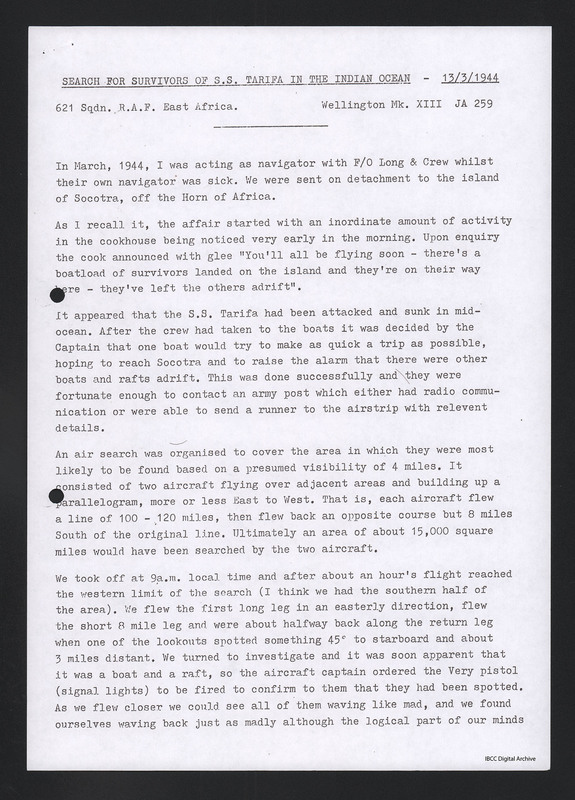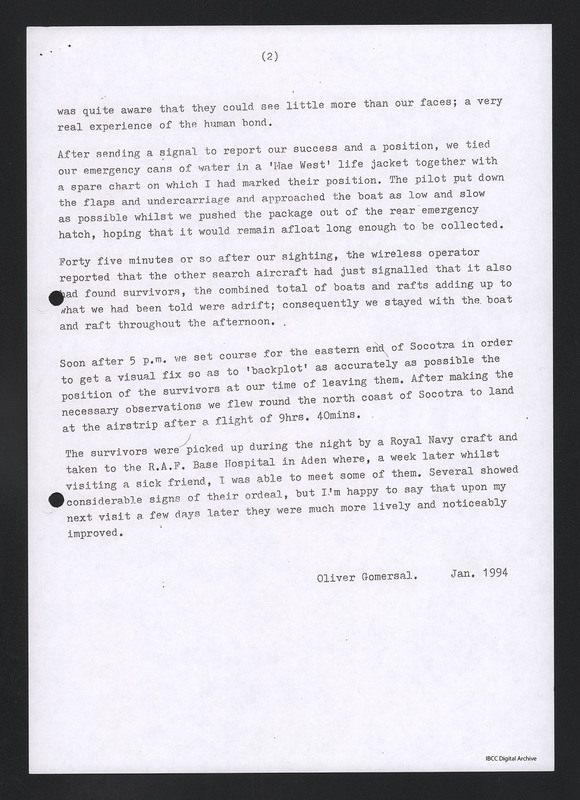Search for survivors of SS Tarifa in the Indian Ocean
Title
Search for survivors of SS Tarifa in the Indian Ocean
Description
Account of search while on 621 Squadron, RAF East Africa in Wellington JA 259 for survivors of SS Tarifa sunk in mid ocean 13 March 1944. Found a boat and raft, fixed position and dropped water cans. Stayed with boat throughout the afternoon and updated fix before departing. Survivors were picked up that night by Royal Navy.
Creator
Temporal Coverage
Language
Format
Two page typewritten document
Publisher
Rights
This content is available under a CC BY-NC 4.0 International license (Creative Commons Attribution-NonCommercial 4.0). It has been published ‘as is’ and may contain inaccuracies or culturally inappropriate references that do not necessarily reflect the official policy or position of the University of Lincoln or the International Bomber Command Centre. For more information, visit https://creativecommons.org/licenses/by-nc/4.0/ and https://ibccdigitalarchive.lincoln.ac.uk/omeka/legal.
Contributor
Identifier
BGomersalOGomersalOv2
Transcription
underlined] SEARCH FOR SURVIVORS OF S.S. TARIFA IN THE INDIAN OCEAN - 13/3/1944 [/underlined]
621 Sqdn. R.A.F. East Africa.
Wellington Mk. XIII JA 259
In March, 1944, I was acting as navigator with F/O Long & Crew whilst their own navigator was sick. We were sent on detachment to the island of Socotra, off the Horn of Africa.
As I recall it, the affair started with an inordinate amount of activity in the cookhouse being noticed very early in the morning. Upon enquiry the cook announced with glee “You’ll all be flying soon - there’s a boatload of survivors landed on the island and they’re on their way here - they’ve left the others adrift”.
It appeared that the S.S. Tarifa had been attacked and sunk in mid-ocean. After the crew had taken to the boats it was decided by the Captain that one boat would try to make as quick a trip as possible, hoping to reach Socotra and to raise the alarm that there were other boats and rafts adrift. This was done successfully and they were fortunate enough to contact an army post which either had radio communication or were [sic] able to send a runner to the airstrip with relevent [sic] details.
An air search was organised to cover the area in which they were most likely to be found based on a presumed visibility of 4 miles. It consisted of two aircraft flying over adjacent areas and building up a parallelogram, more or less East to West. That is, each aircraft flew a line of 100 - 120 miles, then flew back an opposite course but 8 miles South of the original line. Ultimately an area of about 15,000 square miles would have been searched by the two aircraft.
We took off at 9a.m. local time and after about an hour’s flight reached the western limit of the search (I think we had the southern half of the area). We flew the first long leg in an easterly direction, flew the short 8 mile leg and were about halfway back along the return leg when one of the lookouts spotted something 45 º to starboard and about 3 miles distant. We turned to investigate and it was soon apparent that it was a boat and a raft, so the aircraft captain ordered the Very pistol (signal lights) to be fired to confirm to them that they had been spotted. As we flew closer we could see all of them waving like mad, and we found ourselves waving back just as madly although the logical part of our minds
[page break]
was quite aware that they could see little more than our faces; a very real experience of the human bond.
After sending a signal to report our success and a position, we tied our emergency cans of water in a ‘Mae West’ life jacket together with a spare chart on which I had marked their position. The pilot put down the flaps and undercarriage and approached the boat as low and slow as possible whilst we pushed the package out of the rear emergency hatch, hoping that it would remain afloat long enough to be collected.
Forty five minutes or so after our sighting, the wireless operator reported that the other search aircraft had just signalled that it also had found survivors, the combined total of boats and rafts adding up to what we had been told were adrift; consequently we stayed with the boat and raft throughout the afternoon.
Soon after 5 p.m. we set course for the eastern end of Socotra in order to get a visual fix so as to ‘backplot’ as accurately as possible the position of the survivors at our time of leaving them. After making the necessary observations we flew round the north coast of Socotra to land at the airstrip after a flight of 9hrs. 40mins.
The survivors were picked up during the night by a Royal Navy craft and taken to the R.A.F. Base Hospital in Aden where, a week later whilst visiting a sick friend, I was able to meet some of them. Several showed considerable signs of their ordeal, but i’m happy to say that upon my next visit a few days later they were much more lively and noticeably improved.
Oliver Gomersal. Jan. 1994
621 Sqdn. R.A.F. East Africa.
Wellington Mk. XIII JA 259
In March, 1944, I was acting as navigator with F/O Long & Crew whilst their own navigator was sick. We were sent on detachment to the island of Socotra, off the Horn of Africa.
As I recall it, the affair started with an inordinate amount of activity in the cookhouse being noticed very early in the morning. Upon enquiry the cook announced with glee “You’ll all be flying soon - there’s a boatload of survivors landed on the island and they’re on their way here - they’ve left the others adrift”.
It appeared that the S.S. Tarifa had been attacked and sunk in mid-ocean. After the crew had taken to the boats it was decided by the Captain that one boat would try to make as quick a trip as possible, hoping to reach Socotra and to raise the alarm that there were other boats and rafts adrift. This was done successfully and they were fortunate enough to contact an army post which either had radio communication or were [sic] able to send a runner to the airstrip with relevent [sic] details.
An air search was organised to cover the area in which they were most likely to be found based on a presumed visibility of 4 miles. It consisted of two aircraft flying over adjacent areas and building up a parallelogram, more or less East to West. That is, each aircraft flew a line of 100 - 120 miles, then flew back an opposite course but 8 miles South of the original line. Ultimately an area of about 15,000 square miles would have been searched by the two aircraft.
We took off at 9a.m. local time and after about an hour’s flight reached the western limit of the search (I think we had the southern half of the area). We flew the first long leg in an easterly direction, flew the short 8 mile leg and were about halfway back along the return leg when one of the lookouts spotted something 45 º to starboard and about 3 miles distant. We turned to investigate and it was soon apparent that it was a boat and a raft, so the aircraft captain ordered the Very pistol (signal lights) to be fired to confirm to them that they had been spotted. As we flew closer we could see all of them waving like mad, and we found ourselves waving back just as madly although the logical part of our minds
[page break]
was quite aware that they could see little more than our faces; a very real experience of the human bond.
After sending a signal to report our success and a position, we tied our emergency cans of water in a ‘Mae West’ life jacket together with a spare chart on which I had marked their position. The pilot put down the flaps and undercarriage and approached the boat as low and slow as possible whilst we pushed the package out of the rear emergency hatch, hoping that it would remain afloat long enough to be collected.
Forty five minutes or so after our sighting, the wireless operator reported that the other search aircraft had just signalled that it also had found survivors, the combined total of boats and rafts adding up to what we had been told were adrift; consequently we stayed with the boat and raft throughout the afternoon.
Soon after 5 p.m. we set course for the eastern end of Socotra in order to get a visual fix so as to ‘backplot’ as accurately as possible the position of the survivors at our time of leaving them. After making the necessary observations we flew round the north coast of Socotra to land at the airstrip after a flight of 9hrs. 40mins.
The survivors were picked up during the night by a Royal Navy craft and taken to the R.A.F. Base Hospital in Aden where, a week later whilst visiting a sick friend, I was able to meet some of them. Several showed considerable signs of their ordeal, but i’m happy to say that upon my next visit a few days later they were much more lively and noticeably improved.
Oliver Gomersal. Jan. 1994
Collection
Citation
Oliver Gomersal, “Search for survivors of SS Tarifa in the Indian Ocean,” IBCC Digital Archive, accessed October 29, 2024, https://ibccdigitalarchive.lincoln.ac.uk/omeka/collections/document/5877.
Item Relations
This item has no relations.


